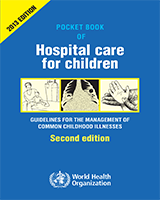All rights reserved. Publications of the World Health Organization are available on the WHO web site (www.who.int) or can be purchased from WHO Press, World Health Organization, 20 Avenue Appia, 1211 Geneva 27, Switzerland (tel.: +41 22 791 3264; fax: +41 22 791 4857; e-mail: tni.ohw@sredrokoob). Requests for permission to reproduce or translate WHO publications – whether for sale or for non-commercial distribution – should be addressed to WHO Press through the WHO web site (www.who.int/about/licensing/copyright_form/en/index.html).
NCBI Bookshelf. A service of the National Library of Medicine, National Institutes of Health.
Pocket Book of Hospital Care for Children: Guidelines for the Management of Common Childhood Illnesses. 2nd edition. Geneva: World Health Organization; 2013.

Pocket Book of Hospital Care for Children: Guidelines for the Management of Common Childhood Illnesses. 2nd edition.
Show detailsThis section gives the doses of the drugs mentioned in these guidelines that are suitable for infants and children. For ease of use and to avoid having to make calculations, doses are given according to the body weight of the child. As errors in calculating drug doses are common in hospital practice worldwide, calculations should be avoided, when possible. Doses are given covering a range of body weights, from 3–29 kg. A table for neonates in the first 2 months of life is included in Chapter 3.
For some drugs (for example, antiretroviral drugs), however, it is better to calculate the exact individual doses on the basis of the body weight of the child, where this is possible. The drugs include those for which the exact dose is critically important to ensure a therapeutic effect or to avoid toxicity, e.g. digoxin, chloramphenicol, aminophylline and antiretroviral drugs.
For some antiretroviral drugs, the recommended dosages are often given according to the surface area of the child. A table giving approximate child surface area for different weight categories is given below to help in this calculation. The doses in the table can then be used to check that the calculated dose is approximately correct (and to check that a calculation error has not been made).
Thus, a child weighing 10 kg and 72 cm long has a body surface area of
Table A2.1Drug dosage by surface area (m2) of the child
| Age or weight of child | Surface area (m2) |
|---|---|
| Neonate (< 1 month) | 0.2–0.25 |
| Young infant (1–< 3 months) | 0.25–0.35 |
| Child 5–9 kg | 0.3–0.45 |
| Child 10–14 kg | 0.45–0.6 |
| Child 15–19 kg | 0.6–0.8 |
| Child 20–24 kg | 0.8–0.9 |
| Child 25–29 kg | 0.9–1.1 |
| Child 30–39 kg | 1.1–1.3 |
Example: if the recommended dose is given as 400 mg/m2 twice a day, then for a child in the weight range 15–19 kg the recommended dose range will be: (0.6–0.8) × 400 = 244−316 mg twice a day.
ABACAVIR (PDF, 37K)
AMINOPHYLLINE (PDF, 37K)
ANTITUBERCULOSIS ANTIBIOTICS (PDF, 39K)
BENZATHINE PENICILLIN (PDF, 31K)
CHLORAMPHENICOL (PDF, 32K)
CIPROFLOXACIN (PDF, 32K)
CO-TRIMOXAZOLE (PDF, 39K)
DIDANOSINE (PDF, 34K)
FENTANYL (PDF, 29K)
GENTAMICIN (PDF, 34K)
KANAMYCIN (PDF, 34K)
METOCLOPRAMIDE (PDF, 32K)
BENZATHINE BENZYLPENICILLIN (PDF, 32K)
POTASSIUM CHLORIDE (PDF, 32K)
QUININE (PDF, 39K)
ANTITUBERCULOUS ANTIBIOTICS (PDF, 29K)
ANTIRETROVIRALS (PDF, 45K)
- Drug dosages and regimens - Pocket Book of Hospital Care for ChildrenDrug dosages and regimens - Pocket Book of Hospital Care for Children
- cytochrome oxidase subunit I, partial (mitochondrion) [Hoplarchus psittacus]cytochrome oxidase subunit I, partial (mitochondrion) [Hoplarchus psittacus]gi|333036288|gb|AEF13043.1|Protein
- UNVERIFIED_ASMBLY: Hoplarchus psittacus short wavelength sensitive opsin 2a-like...UNVERIFIED_ASMBLY: Hoplarchus psittacus short wavelength sensitive opsin 2a-like (SWS2a) gene, partial sequencegi|2004246145|gb|MW401122.1|Nucleotide
Your browsing activity is empty.
Activity recording is turned off.
See more...